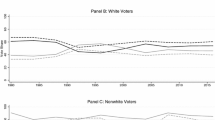Abstract
In their competition for the 2008 Democratic nomination, Barack Obama and Hillary Clinton developed distinct demographic bases of support. This study will analyze the demographic divides in the 2008 Democratic presidential primaries, focusing on the “gaps” that emerged in the support of Obama. Obama’s demographic bases of support were African-Americans, younger voters, educated voted, those with no religion affiliation, wealthier voters, males, political independents, and ideological liberals. Despite the considerable amount of attention given to the gender gap, a number of demographic gaps were more significant. Race was by far the most important gap and a key component of Obama’s victory was his tremendous support from African-American voters.








Similar content being viewed by others
Further Reading
Abromowitz, A. I. 2006. Rejoinder. In P. S. Nivola & D. W. Brady (Eds.), Red and blue nation? (pp. 111–114). Washington: Brookings Institution.
Almond, G., & Verba, S. 1965. The civic culture. Boston: Little, Brown & Company.
Bartels, L. 2000. Partisanship and voting behavior, 1952–1996. American Journal of Political Science, 44, 35–50.
Burns, Q. 2007. “Black vote not sure thing for Obama,” ABC News, February 5.
CNN/Opinion Research Corporation Poll. 2007. CNN/Opinion Research Corporation Poll, October 12–14.
Fiorina, M. 2005. Culture war?: The myth of a polarized America. New York: Pearson Longman.
Jacobson, G. C. 2007. A divider, not a uniter: George Bush and the American People. New York: Pearson Longman.
Judis, J., & Teixeira, R. 2002. The emerging democratic majority. New York: Scribner.
Layman, G. C. 1999. ‘Culture wars’ in the American party system. American Politics Quarterly, 27, 89–121.
McCarty, N., Poole, K. T., & Rosenthal, H. 2006. Polarized America: The dance of ideology and unequal riches. Cambridge: MIT.
Nagourney, A., & Thee, M. 2007. “Young Americans are Leaning Left, New Poll Finds,” New York Times June 27, A1.
Obama, B. 2006. The audacity of hope. New York: Three Rivers.
Schaller, T. F. 2006. Whistling past Dixie. New York: Simon and Schuster.
Author information
Authors and Affiliations
Corresponding author
Rights and permissions
About this article
Cite this article
Fisher, P. The Gapology of the Obama Vote in the 2008 Democratic Presidential Primaries. Soc 48, 502–509 (2011). https://doi.org/10.1007/s12115-011-9487-7
Published:
Issue Date:
DOI: https://doi.org/10.1007/s12115-011-9487-7




